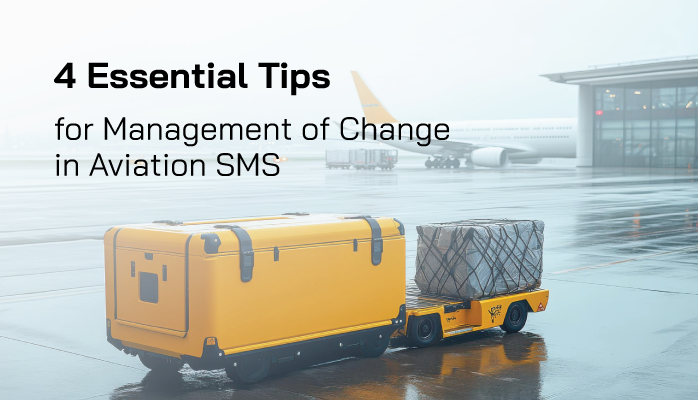Why Change Management in Aviation SMS Is Important

Management of change in aviation safety management systems (SMS) is a complex undertaking because so often it involves performing in-depth risk analysis and risk assessments on current and hypothetical
- hazards,
- equipment;
- processes and procedures;
- environments, and
- one-off situations.
If change management is not performed thoroughly, organizations place themselves at the mercy of unexpected events, as well as the overlooked deterioration of existing risk controls due to the change.
Related Management of Change Articles
- What Is Management of Change in Aviation SMS
- What Are Best Practices for Change Management in Aviation SMS
- 4 Pillars | Most Important Elements of Change Management in Aviation SMS
Management of change can cover anything in an aviation SMS related to aviation safety, such as:
- Regulatory changes;
- New routes, vehicles, or aircraft;
- Organizational restructuring; and
- Changes in integral procedures or management personnel (such as a new Safety Manager).
The list goes on, but the fact is that internal and external environments are constantly changing and change management is how aviation SMS programs adapt. Hence, the change management process of proactively (i.e. ahead of time) identifying potential safety concerns.
As a part of this process, there are 4 things you should know about the management of change in aviation SMS implementations.
1 – Aviation SMS Change Management Principles
At the most basic level, you need to know:
- How you are performing the change management; and
- Why you are performing it.
On the second point, we aren’t talking about the obvious, explicit “why” – which is to identify how the change will affect the existing SMS environment and what new safety concerns the change will introduce. We are talking about the underlying goals of all management of change (MOC) operations. In every MOC, you need to be clear that you:
- Are assessing current safety culture;
- Need to gain top-level endorsement;
- Are stating the case for change;
- Are communicating the plan;
- Need to identify threats;
- Will necessarily involve everyone possibly affected; and
- Most importantly, are creating ownership of changes.
While I realize the above points, which are interpreted from ACT’s Change Management Principles, are terribly conceptual, it’s your responsibility to make each item obvious while performing each management of change operation.
Related Management of Change Articles
- Understanding Management of Change in Aviation SMS
- Relationship Between Management of Change, SA Process, and SRM Process
- 3 Tips for Effective Management of Change Projects in Aviation SMS
2 – How to Manage the Management of Change Process

Your management of change process must be consistent each time, both in terms of analyzing changes and implementing them. When your process is inconsistent or waivers from MOC project to MOC project, so too will the effectiveness of your change management operations.
Here are 4 simple ways to manage the management of change process:
- Standardize your change management methodologies, so that every step of your process is documented and followed in the same order every time;
- Employ your best risk analysis strategies on the safety case involved with the change – I personally recommend an in depth bowtie analysis to cover all bases of threats, events, controls, and impacts;
- Document everything to ensure that all checklist is completed, all approvals given, and, before implementation, you have a nice overview of the entire process - thus making it easier to spot any holes in your process; and
- Implement the change in small, easy-to-digest tasks, such as by using a handful of corrective actions and preventative actions to attack each piece of the needed change.
3 – How You Find New Hazards
Remember that one of the primary purposes of change management is to identify threats that the change will bring. This also means that during the MOC process, you have a golden opportunity to identify new hazards. I particularly think that in real-world scenarios, change management attempts to expose threats and root causes.
Going into change management with the mindset that one of your primary goals is to identify new root cause threats will allow your change management to be more specific than, say, if you carry the mindset that changes management's goal is to identify Top Events (i.e. the point at which the safety of a situation becomes out of control).
During the management of change in aviation SMS, safety managers should specifically look at the change management process in terms of new threats introduced to the SMS because of the change, as well as how currently identified threats change.
4 – Opportunity to Examine Existing Risk Controls
In addition to identifying new hazards, management of change in aviation SMS should inherently be an analysis of existing risk controls. This is because during the hazard analysis process, looking at threats without viewing them in relation to risk controls is like playing a game of basketball without a backboard - you can still do it, but it will not reflect the actual performance of day-to-day operations. When you identify a hazard you should make it common practice to also see how effective the relevant risk control is.
For example, let's say you are an airport, and you are going to upgrade all computers to the latest version of your operating system. One threat is that your airport's entire server base will become unstable with the update and render the airport offline. If you take that at face value, that threat looks pretty serious. But if, at the same time, you take into account that one of your controls is that you already have a redundant (backup) server in place that will automatically take over should the main server go down, that new threat (unstable server) is negligible.
One of the important reasons for examining existing risk controls at the same time as identifying new hazards during change management is because, as you saw in the example, it clarifies which new threats are most important to your change.
Related Management of Change Articles
- How to be Compliant With ICAO Change Management Requirement
- 7 Tips Safety Managers Use to Manage Change in Aviation SMS
- What Is Change Management in Your Aviation SMS?
Final Thoughts on Management of Change
Managing change in aviation SMS will become a constant activity for every aviation service provider required to implement SMS. This becomes especially relevant to operators considering expanding their operations or changing the way they have historically conducted operations.
Is your company able to manage change to the satisfaction of the civil aviation authorities? The best advice that anyone can provide on the management of change is for you to adopt a repeatable, documented process. Don't be afraid that the process is not entirely correct the first few times; however, strive for a repeatable process. Using low-cost, commercially available SMS database software is among the quickest ways to adopt a formal change management process.
SMS database software has been designed to satisfy regulatory requirements. The fastest and least expensive way to acquire risk management processes is by adopting an SMS database. These SMS databases are designed with regulatory compliance as one of their main goals.
Looking for Aviation SMS Software With Management of Change Features?
If you need help with managing MOC projects in your aviation SMS, we can help. Please watch these short demo videos to learn how you can benefit from this low-cost SMS database.
Last updated December 2025.







